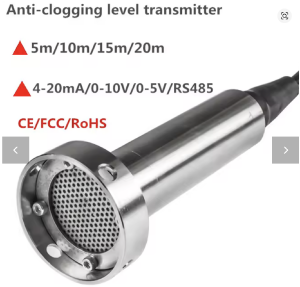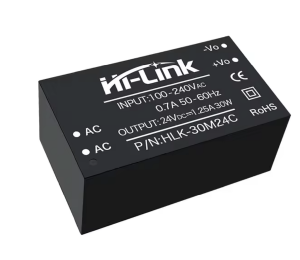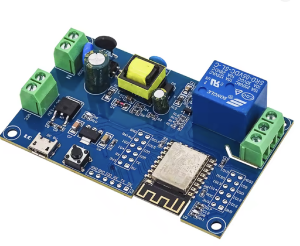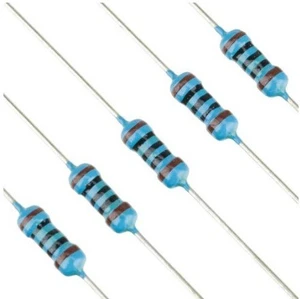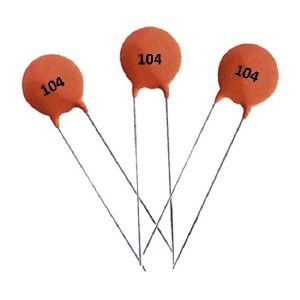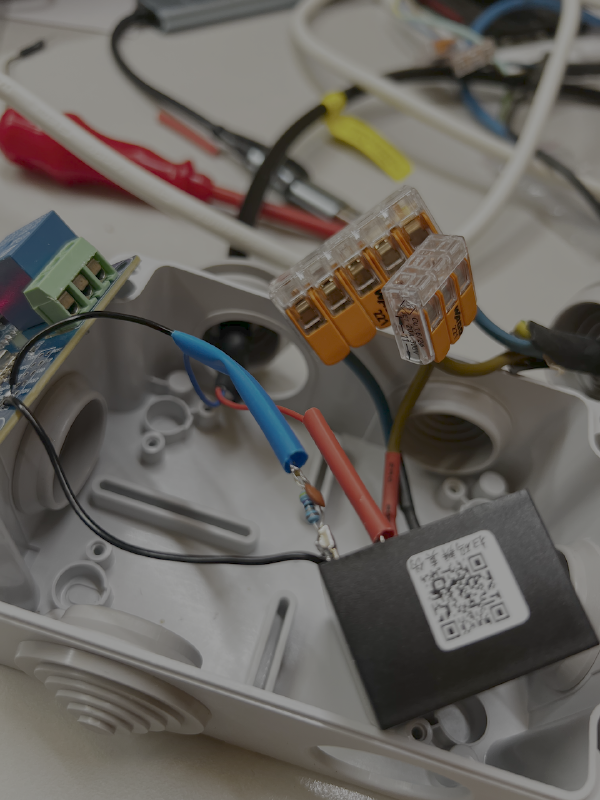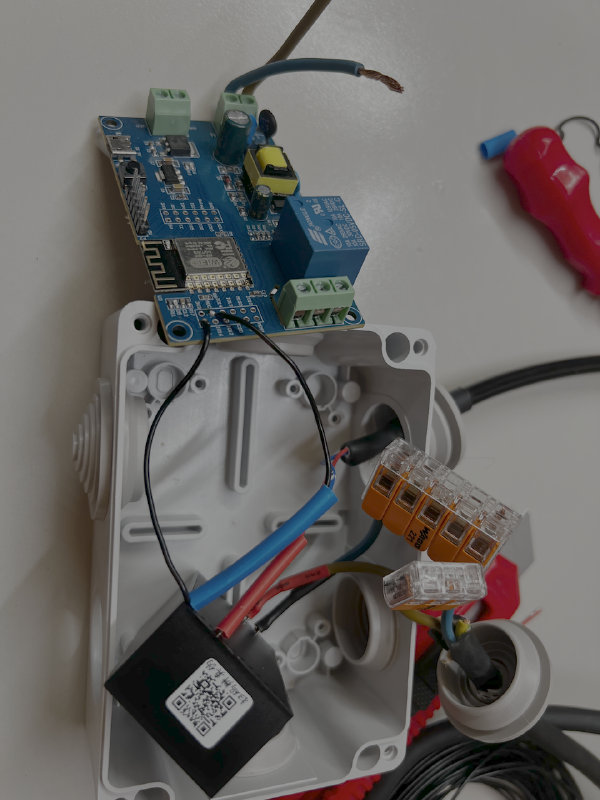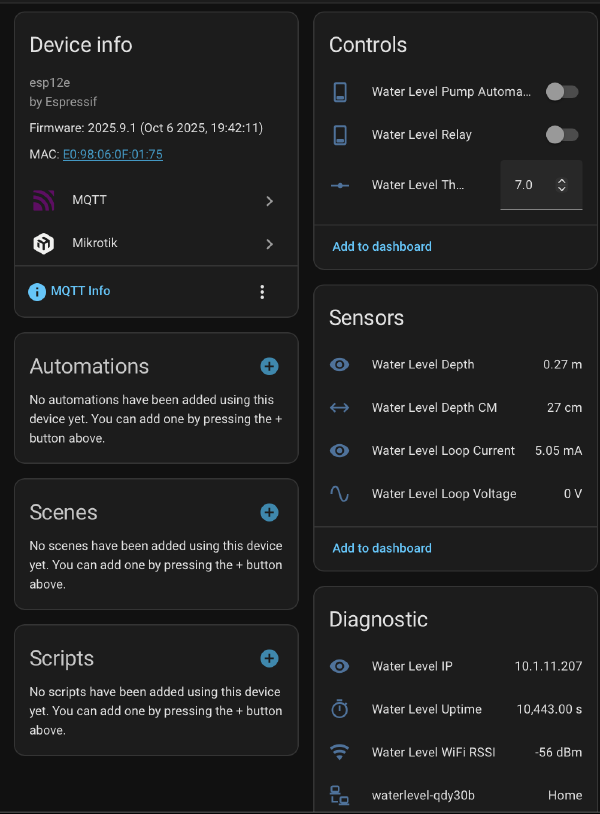Water level QDY30B: Skirtumas tarp puslapio versijų
| 49 eilutė: | 49 eilutė: | ||
== ESPHome Firmware kodas == | == ESPHome Firmware kodas == | ||
| − | <syntaxhighlight lang=" | + | === water_level.yaml === |
| − | + | ||
| + | Pagrindinis esphome aprašas/kodas: | ||
| + | <syntaxhighlight lang="yaml"> | ||
| + | substitutions: | ||
| + | device_name: waterlevel-qdy30b | ||
| + | friendly_name: "Water Level" | ||
| + | r_shunt_ohm: "47.0" # 47 Ω | ||
| + | max_depth_m: "5.0" # probe range max (meters) | ||
| + | zero_offset_cm: "-6.0" # offset calibration: 33 → 27 cm, so -6 cm | ||
| + | threshold_max_cm: "500.0" # 5.0 m × 100 = 500 cm | ||
| + | relay_gpio: GPIO15 # Board relay pin which is soldered to | ||
| + | |||
| + | esphome: | ||
| + | name: ${device_name} | ||
| + | on_boot: | ||
| + | priority: 800 | ||
| + | then: | ||
| + | - delay: 500ms | ||
| + | - lambda: |- | ||
| + | id(apply_control).execute(); | ||
| + | preferences: | ||
| + | flash_write_interval: 10s | ||
| + | |||
| + | esp8266: | ||
| + | board: esp12e | ||
| + | restore_from_flash: true # restore states after power off | ||
| + | |||
| + | wifi: | ||
| + | ssid: !secret wifi_ap | ||
| + | password: !secret wifi_password | ||
| + | ap: # fallback AP if Wi-Fi fails | ||
| + | ssid: "${device_name}_AP" | ||
| + | password: !secret wifi_direct | ||
| + | |||
| + | mqtt: | ||
| + | broker: !secret mqtt_broker | ||
| + | client_id: ${device_name}-client | ||
| + | username: water_level | ||
| + | password: MyMQTTPassword | ||
| + | discovery: true | ||
| + | |||
| + | logger: | ||
| + | ota: | ||
| + | - platform: esphome | ||
| + | web_server: # small built-in web page for quick checks | ||
| + | port: 80 | ||
| + | |||
| + | |||
| + | # --- RELAY (physical output) --- | ||
| + | switch: | ||
| + | - platform: gpio | ||
| + | id: pump_relay | ||
| + | name: "${friendly_name} Relay" | ||
| + | pin: | ||
| + | number: ${relay_gpio} | ||
| + | inverted: false # set to true if your relay is active-LOW | ||
| + | restore_mode: RESTORE_DEFAULT_OFF # restores last known state (if none saved, default OFF) | ||
| + | |||
| + | - platform: template | ||
| + | id: auto_enable | ||
| + | name: "${friendly_name} Pump Automation" | ||
| + | optimistic: true | ||
| + | restore_mode: RESTORE_DEFAULT_OFF # restores last saved; defaults OFF if none yet | ||
| + | turn_on_action: | ||
| + | - lambda: |- | ||
| + | id(apply_control).execute(); | ||
| + | turn_off_action: | ||
| + | - logger.log: "Automation disabled — relay left unchanged." | ||
| + | |||
| + | |||
| + | # --- SENSORS --- | ||
| + | sensor: | ||
| + | # Raw voltage across the shunt (A0 is 0..1.0 V on ESP12F) | ||
| + | - platform: adc | ||
| + | pin: A0 | ||
| + | id: loop_voltage | ||
| + | name: "${friendly_name} Loop Voltage" | ||
| + | unit_of_measurement: "V" | ||
| + | accuracy_decimals: 3 | ||
| + | update_interval: 1s | ||
| + | filters: | ||
| + | # light smoothing; A0 can be a bit noisy | ||
| + | - median: | ||
| + | window_size: 7 | ||
| + | send_every: 3 | ||
| + | send_first_at: 1 | ||
| + | |||
| + | # Convert V -> current (mA): I = V / R * 1000 | ||
| + | - platform: template | ||
| + | id: loop_current | ||
| + | name: "${friendly_name} Loop Current" | ||
| + | unit_of_measurement: "mA" | ||
| + | accuracy_decimals: 2 | ||
| + | update_interval: 1s | ||
| + | lambda: |- | ||
| + | return (id(loop_voltage).state / ${r_shunt_ohm}) * 1000.0; | ||
| + | filters: | ||
| + | # keep values in a sane range | ||
| + | - clamp: | ||
| + | min_value: 0.0 | ||
| + | max_value: 30.0 | ||
| + | |||
| + | - platform: wifi_signal | ||
| + | name: "${friendly_name} WiFi RSSI" | ||
| + | update_interval: 30s | ||
| + | - platform: uptime | ||
| + | name: "${friendly_name} Uptime" | ||
| + | |||
| + | # Depth in centimeters (from the computed meters) | ||
| + | - platform: template | ||
| + | id: water_depth_cm | ||
| + | name: "${friendly_name} Depth CM" | ||
| + | unit_of_measurement: "cm" | ||
| + | device_class: distance | ||
| + | state_class: measurement | ||
| + | accuracy_decimals: 0 # whole centimeters; set 1 if you want 0.1 cm | ||
| + | update_interval: 1s | ||
| + | lambda: |- | ||
| + | // reuse the meters reading we already compute | ||
| + | return id(water_depth).state * 100.0; | ||
| + | on_value: | ||
| + | then: | ||
| + | - lambda: |- | ||
| + | id(apply_control).execute(); | ||
| + | |||
| + | # Map 4–20 mA to 0–MAX_DEPTH meters | ||
| + | - platform: template | ||
| + | id: water_depth | ||
| + | name: "${friendly_name} Depth" | ||
| + | unit_of_measurement: "m" | ||
| + | accuracy_decimals: 2 | ||
| + | update_interval: 1s | ||
| + | lambda: |- | ||
| + | const float I = id(loop_current).state; // mA | ||
| + | float d = (I - 4.0f) / 16.0f * ${max_depth_m}; // ideal meters | ||
| + | d += (${zero_offset_cm} / 100.0f); // apply offset in meters | ||
| + | if (d < 0.0f) d = 0.0f; | ||
| + | if (d > ${max_depth_m}) d = ${max_depth_m}; | ||
| + | return d; | ||
| + | filters: | ||
| + | - throttle: 1s | ||
| + | |||
| + | |||
| + | number: | ||
| + | - platform: template | ||
| + | id: threshold_cm | ||
| + | name: "${friendly_name} Threshold (cm)" | ||
| + | min_value: 0.0 | ||
| + | max_value: ${threshold_max_cm} # must be a number, not a lambda | ||
| + | step: 1.0 | ||
| + | optimistic: true | ||
| + | restore_value: true | ||
| + | initial_value: 30.0 | ||
| + | set_action: | ||
| + | - lambda: |- | ||
| + | id(apply_control).execute(); | ||
| + | |||
| + | # Optional: handy extras | ||
| + | text_sensor: | ||
| + | - platform: wifi_info | ||
| + | ip_address: | ||
| + | name: "${friendly_name} IP" | ||
| + | |||
| + | script: | ||
| + | - id: apply_control | ||
| + | mode: restart | ||
| + | then: | ||
| + | - if: | ||
| + | condition: | ||
| + | switch.is_on: auto_enable | ||
| + | then: | ||
| + | - if: | ||
| + | condition: | ||
| + | lambda: |- | ||
| + | return id(water_depth_cm).state > id(threshold_cm).state; | ||
| + | then: | ||
| + | - if: | ||
| + | condition: | ||
| + | switch.is_off: pump_relay | ||
| + | then: | ||
| + | - logger.log: "Automation: depth > threshold → Relay ON" | ||
| + | - switch.turn_on: pump_relay | ||
| + | else: | ||
| + | - if: | ||
| + | condition: | ||
| + | switch.is_on: pump_relay | ||
| + | then: | ||
| + | - logger.log: "Automation: depth ≤ threshold → Relay OFF" | ||
| + | - switch.turn_off: pump_relay | ||
| + | else: | ||
| + | - logger.log: "Automation disabled — no action taken." | ||
| + | </syntaxhighlight> | ||
| + | |||
| + | === secrets.yaml === | ||
| + | |||
| + | Šiame faile aprašoma wifi/mqtt/slaptažodžiai. | ||
| + | <syntaxhighlight lang="yaml"> | ||
| + | wifi_ap: SSID | ||
| + | wifi_password: 123456789 | ||
| + | wifi_direct: 123456789 | ||
| + | mqtt_broker: 192.168.1.1 | ||
</syntaxhighlight> | </syntaxhighlight> | ||
| + | |||
== Flashinimas == | == Flashinimas == | ||
| 59 eilutė: | 260 eilutė: | ||
Flashinti reikia per relės UART interfeisą, micro USB interfeisas tam reikalui neskirtas. Pajungiame USB Serial TTL adapterį, sujungiame RX/TX/GND/5V ir galime flashinti, pirmam kartui taip pat būtina užtrumpinti GND + 101 prieš įjungiant įrenginį (randasi tame pačiame UART layoute). | Flashinti reikia per relės UART interfeisą, micro USB interfeisas tam reikalui neskirtas. Pajungiame USB Serial TTL adapterį, sujungiame RX/TX/GND/5V ir galime flashinti, pirmam kartui taip pat būtina užtrumpinti GND + 101 prieš įjungiant įrenginį (randasi tame pačiame UART layoute). | ||
| + | |||
| + | Norint, kad veiktų rėlė taip pat reikia sulituoti kartu pinus: '''Relay + 1015'''. | ||
Kompiluojame ir flashiname: | Kompiluojame ir flashiname: | ||
22:15, 6 spalio 2025 versija
Vandens lygio matuoklis paremtas QDY30B sensoriumi. Pagrindinė sprendžiama problema: hidroforo išjungimas pasiekus kritinį vandens lygio tašką, t.y kai hidroforo įėimo vamzdis nepasiekia vandens išjungti jam maitinimą. Taip pat papildomai integracija į MQTT/Home Assistant vandens lygio matavimams centimetrais/metrais.
Reikalingos medžiagos
- Submersible Liquid Level Sensor Water Tank Pressure Transmitter 4-20mA 0-10V RS485 Water River Level Transmitter šiame aprašyme naudojamas 4-20mA output, 5M range 10m cable
- Hi-Link 30W 24 AC DC Single Output Power Supply Module HLK-30M24C
- ESP8266 WIFI Wireless Relay Module ESP-12F AC 220V DC 5V 12V Power Supply ESP 12F Development Board Remote Control Smart Home modulis su ESP-12F
- Metal Film Resistor 2W 47R tipas 2W 47R
- Ceramic Capacitor 104 0.1uF 100NF 50V tipas 104
- Bet kokia elektros paskirstymo hermetinė IP66 dėžutė iš Senukų arba Ermitažo (kad tilptų viskas sugrūsti).
Kaip atrodo medžiagos
Sujungimo schema
From Sensor (Blue wire, 4–20 mA −)
│
│
├───────> To ESP8266 ADC0 (A0) ← sense wire
│
│
[===] ← 47 Ω resistor (shunt)
[ ]
│
│
GND (shared with 24 V PSU and ESP8266)
Sujungimas:
- Prijungiame mėlyną sensoriaus laidą prie vienos 50R rezistoriaus kojos.
- Kitą rezistoriaus koją prijungiame prie žemės (GND).
- Prilituojame keramikinį kondensatorių tiesiai per abi rezistoriaus kojas (lygiagrečiai).
- Nuo mėlyno laido pusės (kur prijungtas prie rezistoriaus) išvedame trumpą laidą į ESP8266 ADC0 (A0) įėjimą.
- Įsitikiname, kad maitinimo šaltinis (PSU) ir ESP8266 turi bendrą žemę (GND).
Kaip atrodo sujungimas
ESPHome Firmware kodas
water_level.yaml
Pagrindinis esphome aprašas/kodas:
substitutions:
device_name: waterlevel-qdy30b
friendly_name: "Water Level"
r_shunt_ohm: "47.0" # 47 Ω
max_depth_m: "5.0" # probe range max (meters)
zero_offset_cm: "-6.0" # offset calibration: 33 → 27 cm, so -6 cm
threshold_max_cm: "500.0" # 5.0 m × 100 = 500 cm
relay_gpio: GPIO15 # Board relay pin which is soldered to
esphome:
name: ${device_name}
on_boot:
priority: 800
then:
- delay: 500ms
- lambda: |-
id(apply_control).execute();
preferences:
flash_write_interval: 10s
esp8266:
board: esp12e
restore_from_flash: true # restore states after power off
wifi:
ssid: !secret wifi_ap
password: !secret wifi_password
ap: # fallback AP if Wi-Fi fails
ssid: "${device_name}_AP"
password: !secret wifi_direct
mqtt:
broker: !secret mqtt_broker
client_id: ${device_name}-client
username: water_level
password: MyMQTTPassword
discovery: true
logger:
ota:
- platform: esphome
web_server: # small built-in web page for quick checks
port: 80
# --- RELAY (physical output) ---
switch:
- platform: gpio
id: pump_relay
name: "${friendly_name} Relay"
pin:
number: ${relay_gpio}
inverted: false # set to true if your relay is active-LOW
restore_mode: RESTORE_DEFAULT_OFF # restores last known state (if none saved, default OFF)
- platform: template
id: auto_enable
name: "${friendly_name} Pump Automation"
optimistic: true
restore_mode: RESTORE_DEFAULT_OFF # restores last saved; defaults OFF if none yet
turn_on_action:
- lambda: |-
id(apply_control).execute();
turn_off_action:
- logger.log: "Automation disabled — relay left unchanged."
# --- SENSORS ---
sensor:
# Raw voltage across the shunt (A0 is 0..1.0 V on ESP12F)
- platform: adc
pin: A0
id: loop_voltage
name: "${friendly_name} Loop Voltage"
unit_of_measurement: "V"
accuracy_decimals: 3
update_interval: 1s
filters:
# light smoothing; A0 can be a bit noisy
- median:
window_size: 7
send_every: 3
send_first_at: 1
# Convert V -> current (mA): I = V / R * 1000
- platform: template
id: loop_current
name: "${friendly_name} Loop Current"
unit_of_measurement: "mA"
accuracy_decimals: 2
update_interval: 1s
lambda: |-
return (id(loop_voltage).state / ${r_shunt_ohm}) * 1000.0;
filters:
# keep values in a sane range
- clamp:
min_value: 0.0
max_value: 30.0
- platform: wifi_signal
name: "${friendly_name} WiFi RSSI"
update_interval: 30s
- platform: uptime
name: "${friendly_name} Uptime"
# Depth in centimeters (from the computed meters)
- platform: template
id: water_depth_cm
name: "${friendly_name} Depth CM"
unit_of_measurement: "cm"
device_class: distance
state_class: measurement
accuracy_decimals: 0 # whole centimeters; set 1 if you want 0.1 cm
update_interval: 1s
lambda: |-
// reuse the meters reading we already compute
return id(water_depth).state * 100.0;
on_value:
then:
- lambda: |-
id(apply_control).execute();
# Map 4–20 mA to 0–MAX_DEPTH meters
- platform: template
id: water_depth
name: "${friendly_name} Depth"
unit_of_measurement: "m"
accuracy_decimals: 2
update_interval: 1s
lambda: |-
const float I = id(loop_current).state; // mA
float d = (I - 4.0f) / 16.0f * ${max_depth_m}; // ideal meters
d += (${zero_offset_cm} / 100.0f); // apply offset in meters
if (d < 0.0f) d = 0.0f;
if (d > ${max_depth_m}) d = ${max_depth_m};
return d;
filters:
- throttle: 1s
number:
- platform: template
id: threshold_cm
name: "${friendly_name} Threshold (cm)"
min_value: 0.0
max_value: ${threshold_max_cm} # must be a number, not a lambda
step: 1.0
optimistic: true
restore_value: true
initial_value: 30.0
set_action:
- lambda: |-
id(apply_control).execute();
# Optional: handy extras
text_sensor:
- platform: wifi_info
ip_address:
name: "${friendly_name} IP"
script:
- id: apply_control
mode: restart
then:
- if:
condition:
switch.is_on: auto_enable
then:
- if:
condition:
lambda: |-
return id(water_depth_cm).state > id(threshold_cm).state;
then:
- if:
condition:
switch.is_off: pump_relay
then:
- logger.log: "Automation: depth > threshold → Relay ON"
- switch.turn_on: pump_relay
else:
- if:
condition:
switch.is_on: pump_relay
then:
- logger.log: "Automation: depth ≤ threshold → Relay OFF"
- switch.turn_off: pump_relay
else:
- logger.log: "Automation disabled — no action taken."
secrets.yaml
Šiame faile aprašoma wifi/mqtt/slaptažodžiai.
wifi_ap: SSID
wifi_password: 123456789
wifi_direct: 123456789
mqtt_broker: 192.168.1.1
Flashinimas
Pirmiausia reiktų susidiegti esphome python3 modulį:
pip3 install esphome
Flashinti reikia per relės UART interfeisą, micro USB interfeisas tam reikalui neskirtas. Pajungiame USB Serial TTL adapterį, sujungiame RX/TX/GND/5V ir galime flashinti, pirmam kartui taip pat būtina užtrumpinti GND + 101 prieš įjungiant įrenginį (randasi tame pačiame UART layoute).
Norint, kad veiktų rėlė taip pat reikia sulituoti kartu pinus: Relay + 1015.
Kompiluojame ir flashiname:
python3 -m esphome compile water_level.yaml python3 -m esphome upload water_level.yaml
Vėliau galime flashinti over the air (per tinklą) metodu:
python3 -m esphome upload --device DEVICE_IP water_level.yaml
Rezultatas
Kaip matome galime nustatyti kiek CM yra kritinis taškas, žemiau jo relė išsijungia, taip pat galima šią automatiką išjungti arba įjungti. Įjungimo išjungimo būsenos tai pat saugomos po power loss ar atsitiktinių elektros atjungimų, kas yra būtina išlaikant testinumą. Taipogi galima rankiniu būdu valdyti rėlę prieš tai išjungus automatiką. Pagal nutylėjimą pirmam leidimui visos pozicijos yra išjungtos.
